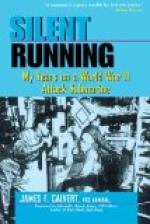Writing in the midst of ruined trenches rocked by the concussion of shells, every message he sent that day, every report he made by orderly after the wires were down was written out very explicitly; which Farquhar had taught him was the army way. The record is there of his coolness when the lid was blown off of hell. For all you can tell by the firm chirography, he might have been sending a note to a ranch foreman.
When his communications were cut, he was not certain how much support he had on his flanks. It looked for a time as if he had none. After the first charge was repulsed, he made contact with the King’s Royal Rifle Corps on his right. He knew from the nature of the first German charge that the second would be worse than the first. The Germans had advanced some machine-guns; they would be able to place their increased artillery fire more accurately.
Again green figures started down that hill and again they were put back. Then Niven was able to establish contact with the Shropshire Light Infantry, another regiment on his left. So he knew that right and left he was supported, and by seasoned British regulars. This was very, very comforting, especially when German machine-gun fire was not only coming from the front but in enfilade, which is most trying to a soldier’s steadiness. In other words, the P.P.s were shooting at Germans in front, while bullets were whipping crosswise of their trenches and of the regulars on their flanks, too. Some of the German infantrymen who had not been hit or had not fallen back had dug themselves cover and were firing at a closer range.
The Germans had located the points in the P.P.s’ trench occupied by machine-guns. At least, they could put these hornets’ nests out of business if not all the individual riflemen. So they concentrated high explosive shells on the guns. This did the trick; it buried them. But a buried machine-gun may be dug out and fired again. It may be dug out two or three times and keep on firing as long as it will work and there is anyone to man it.
While the machine-guns were being exhumed every man in one sector of the trench was killed. Then the left half of the right fire trench had three or four shells, one after another, bang into it. There was no trench left; only macerated earth and mangled men. Those emerging alive were told to retreat to the communication trench. Next, the right end of the left fire trench was blown in. When the survivors fell back to the communication trench that also was blown in their face.
“Oh, but we were having a merry party!” as Lieutenant Vandenberg put it.
Niven and his lieutenants were moving here and there to the point of each new explosion to ascertain the amount of damage and to decide what was to be done as the result. One soldier described Niven’s eyes as sparks emitted from two holes in his dust-caked face.
Pappineau tells how a tree outside the trench was cut in two by a shell and its trunk laid across the breach of the trench caused by another shell; and lying over the trunk, limp and lifeless where he had fallen, was a man killed by still another shell.




